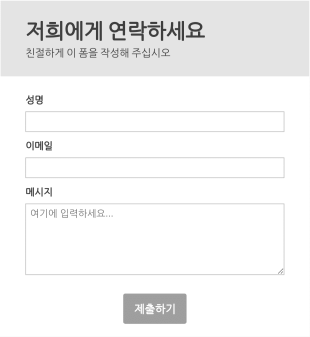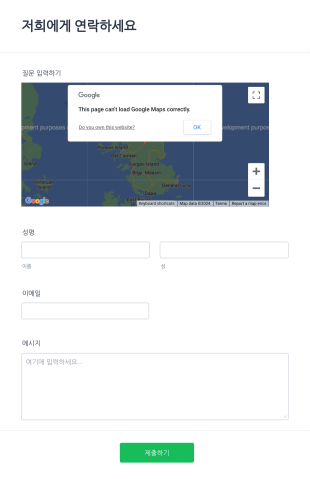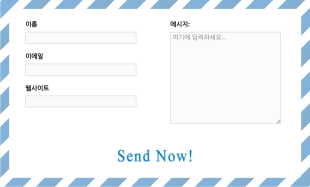문의 양식
문의 양식 정보
문의 양식은 웹사이트 방문자, 고객 또는 클라이언트가 온라인 인터페이스를 통해 조직, 기업 또는 개인에게 직접 연락할 수 있도록 하는 필수 디지털 도구입니다. 일반적으로 웹사이트나 랜딩 페이지에 삽입되며, 이름, 이메일 주소, 전화번호, 메시지 등의 주요 정보를 수집함으로써 커뮤니케이션을 간소화합니다. 일반 문의, 고객 지원 요청, 피드백 수집, 영업 리드 확보, 파트너십 제안, 이벤트 참석 회신 등 다양한 용도로 사용됩니다. 문의 양식은 사용자에게 구조화된 연락 방법을 제공함으로써, 조직이 수신되는 커뮤니케이션을 효율적으로 관리하고 중요한 메시지를 놓치지 않도록 도와줍니다.
Jform을 사용하면 사용자는 직관적인 드래그 앤 드롭 양식 빌더와 바로 사용할 수 있는 방대한 템플릿 라이브러리 덕분에 모든 시나리오에 맞게 연락처 양식을 쉽게 만들고 사용자 정의할 수 있습니다. Jform의 노코드 플랫폼을 통해 기술 전문 지식 없이도 누구나 필드를 추가하거나 수정하고, 이메일 및 CRM 도구와 통합하고, 자동 알림을 설정할 수 있습니다. 제출물은 Jform 테이블에 자동으로 정리되므로 들어오는 모든 메시지를 쉽게 추적, 응답 및 관리할 수 있습니다. 중소기업 소유주, 비영리 단체 또는 대기업의 일부이든 Jform의 연락처 양식은 처음부터 커뮤니케이션을 간소화하고 워크플로를 개선하는 데 도움이 됩니다.
Use Cases of Contact Forms
연락처 양식은 다양한 산업과 조직의 커뮤니케이션 요구를 충족시키기 위해 유연하게 설계될 수 있는 다목적 양식입니다. 이 양식은 문의, 피드백, 요청을 구조적으로 수집할 수 있어 가장 널리 사용되는 양식 중 하나입니다. 사용 사례, 사용자, 필요에 따라 달라질 수 있는 디자인 방식에 대한 예시도 함께 살펴보겠습니다.
1. 사용 가능 사례:
- General inquiries from website visitors or customers.
- Customer support or help desk requests.
- Sales or service quote requests.
- Feedback or testimonial collection.
- Event RSVPs or partnership proposals.
- Media or press inquiries.
- Job application or recruitment queries.
2. 문제 해결 포인트:
- Centralizes communication, reducing the risk of missed messages.
- Filters and categorizes inquiries for faster response times.
- Automates notifications to relevant team members.
- Collects structured data for easier follow-up and analysis.
3. 예상 사용자 및 소유자:
- Small business owners, freelancers, and consultants.
- Customer service and support teams.
- Marketing and sales departments.
- HR and recruitment professionals.
- Nonprofit organizations and educational institutions.
4. 제작 방식 차이점:
- A general inquiry form may only require basic fields (name, email, message).
- A support request form might include dropdowns for issue type, urgency, and file upload options.
- Sales or quote request forms could ask for company details, budget, and specific service interests.
- Feedback forms may use rating scales or multiple-choice questions.
- Event RSVP forms might include date selection and meal preferences.
In summary, contact forms can be easily adapted to suit the unique communication needs of any organization, ensuring that every inquiry is captured and managed efficiently.
How to Create a Contact Form
Creating a contact form with Jform is a straightforward process that empowers you to capture and manage communications efficiently, regardless of your specific use case. Whether you need a simple inquiry form, a detailed support request, or a specialized sales lead form, Jform’s flexible platform allows you to design, customize, and deploy your form in minutes. Here’s a step-by-step guide to help you create a contact form tailored to your needs:
1. 양식 시작
- Jform 계정에 로그인한 뒤, 내 작업 공간 페이지에서 “생성”을 클릭하세요.
- Choose “Form” and decide whether to start from scratch or use one of Jform’s 10,000+ contact form templates for inspiration.
2. 레이아웃 선택:
- Opt for the Classic Form (all questions on one page) for quick inquiries, or Card Form (one question per page) for a more guided experience.
3. 필수 필드 추가:
- Use the drag-and-drop Form Builder to add basic fields such as Name, Email, Phone Number, and Message.
- For specialized use cases, include dropdowns (e.g., inquiry type), checkboxes (e.g., preferred contact method), or file upload fields (for attachments or screenshots).
4. 용도에 맞게 사용자 지정:
- For customer support, add fields for issue category, urgency, and order number.
- For sales inquiries, include company name, budget, and service interest.
- For feedback, add rating scales or multiple-choice questions.
- Use conditional logic to show or hide fields based on user responses, ensuring a streamlined experience.
5. 디자인 개인화:
- 페인트 롤러 아이콘을 클릭하여 양식 디자이너를 여세요.
- 브랜드 아이덴티티에 맞게 색상, 글꼴, 레이아웃을 조정하세요.
- 조직의 로고를 추가해 전문적인 느낌을 더하세요.
6. 알림 설정:
- 설정 메뉴에서 팀이 새 제출 내용을 알 수 있도록 이메일 알림을 구성하세요.
- Set up autoresponder emails to confirm receipt to the user, enhancing trust and transparency.
7. 게시 및 공유
- Click “Publish” to generate a shareable link or embed the form directly on your website.
- Share via email, social media, or QR code as needed.
8. 제출 및 관리 테스트:
- Use the Preview feature to test your form and ensure all fields and notifications work as intended.
- Monitor and manage submissions in Jform Tables, where you can filter, search, and respond efficiently.
By following these steps, you can create a contact form that not only captures the information you need but also provides a seamless experience for your users. Jform’s robust features ensure that your communication process is organized, automated, and scalable as your needs evolve.
자주하는 질문들
1. What is a contact form?
A contact form is an online tool that allows users to send messages, inquiries, or requests directly to an organization or individual through a website or digital platform.
2. Why are contact forms important for websites?
연락처 양식은 방문자가 귀하와 안전하고 구조화된 방식으로 소통할 수 있는 편리한 수단을 제공하며, 스팸을 줄이고 모든 문의를 체계적으로 정리하고 대응하는 데 도움을 줍니다.
3. What information should a contact form collect?
At a minimum, contact forms typically collect the user’s name, email address, and message. Depending on the use case, additional fields like phone number, inquiry type, or file uploads may be included.
4. Are there different types of contact forms?
네, 연락처 양식은 일반 문의, 지원 요청, 영업 문의, 피드백 수집, 이벤트 RSVP 등 다양한 목적으로 맞춤 설정할 수 있으며, 각기 다른 필드와 워크플로우를 포함할 수 있습니다.
5. 누가 연락처 양식을 사용해야 하나요?
웹사이트나 온라인 채널을 운영하는 모든 기업, 조직, 개인은 고객, 클라이언트, 이해관계자와의 원활한 소통을 위해 연락처 양식을 사용할 수 있습니다.
6. How do contact forms help with privacy and data protection?
연락처 양식은 개인정보 보호 규정을 준수하도록 설계할 수 있으며, 동의 체크박스, 개인정보 처리방침 링크, 안전한 데이터 처리 방식 등을 포함하여 사용자 정보를 보호합니다.
7. Can contact forms be integrated with other tools?
네, Jform을 포함한 많은 연락처 양식은 이메일 마케팅 플랫폼, CRM, 헬프데스크 소프트웨어 등 다양한 도구와 통합하여 워크플로우를 자동화하고 응답 시간을 개선할 수 있습니다.
8. What are the best practices for designing an effective contact form?
양식을 간단하고 사용자 친화적으로 유지하세요. 필요한 정보만 요청하고, 명확한 라벨을 사용하며, 확인 메시지를 제공하고, 모바일에서도 잘 작동하도록 반응형으로 디자인하는 것이 중요합니다.





